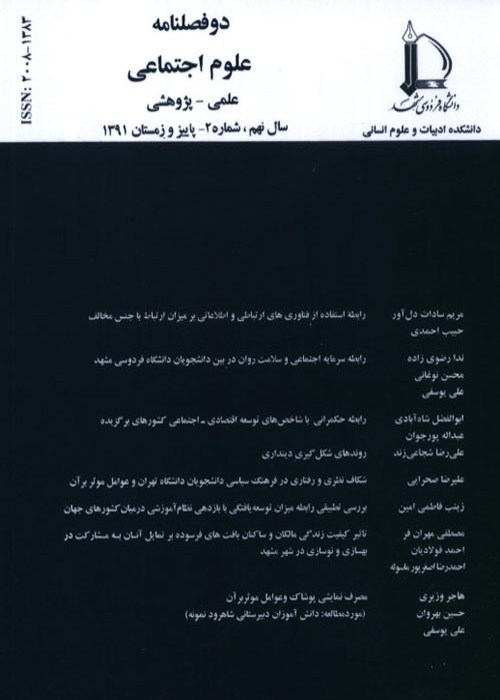Studying the Social Capital Status of the First-Grade High School Students in Tehran
Author(s):
Article Type:
Research/Original Article (دارای رتبه معتبر)
Abstract:
Introduction
Recent organizational research has shown that about 70 percent of learning in educational systems occurs through informal communication and interactions (Sharipour, 2005). The absolute value of education and its various components, such as textbooks, teaching methods, and the socio-psychological environment governing the classroom and school can play an important role in building and strengthening the social capital of the students. Also, many education professionals believe that challenging and at the same time supportive educational environments can facilitate students' academic achievement (Cleifton& Roberts, 1993). For this reason, schools can be rich only when their social relations can challenge the student at a scientific and intellectual levelon the one hand, and can provide a lot of social support to the studentson the other hand. This type of social relationship positively and significantly affects the behavior of the students and their performance (Achevory, Clifton,& Roberts, 2001).Considering that social capital affects the relations between students and their trust,it can be effective in their academic achievement as well. Given that so far no study has been done to examine the social capital in high school students in Tehran, this study is aimed to investigate the status of social capital, its dimensions and indicators in the first grade high school students in Tehran as a case study of hidden curriculum. In so doing, first, the concept of social capital, dimensions and indicators will be described. Second, in light of a field study, the research questionswill be responded.
Theoretical Framework: Social capital is the set of actual and potential interests that comes with the membership in social networks of the actors and organizations, namely, a set of informal norms or values that the members of a group who have the permission for cooperation share (Fukuyama, 2001).
Social capital in general includes institutions, relationships, tendencies, values, and norms that govern the behavior and interactions among the individuals (Grotter& Van Beltler, 2001). In other words, social capital is one of the networks and norms that enable individuals to act collectively (Volckak, 1998). These two definitions encompass all the relevant definitions of the social capital.
Method
The present study is an applied research. In terms of data collection and analysis, it is an analytical-descriptive study. The population of this study consisted of all the first-grade students of high schools in 19th district of Tehran in the academic year of 2007-2008. 897 students were selected for the study. Stratified random sampling method was used forthe research sample. The researcher made questionnaire included 87 questions based on the five- Likert scale (ranging from very small to very high). Cronbach's alpha was used to determine the reliability of the instrument and the second-order confirmatory factor analysis technique was used to determine the validity of the tool.To analyze the data, descriptive statistical techniques such as frequency distribution, central (facade, middle, and mean), and dispersion indices (standard deviation and variance) for demographic variables and social capital variables were used. To answer the questions, weight Measurement Techniques and Friedman Test were used.
Findings: According to the results of the data analysis, the condition of the three groups of students, male and female students in the social capital variable, dimensions, indicators, types, and levels are as follows.
According to the results of Friedman test in three groups, regarding social capital variables, dimensions, indices, types, and levels, it can be said that the rate of index obtained in three groups at the level of 0.01 is significant indicating a significant difference between the mean of the rankings of variables in each group. According to the ranking of the variables in the groups, the following points can be stated.
• The highest rank in the total group of students was related to the common goals variable with the mean of 3.81 and the lowest rank in the total group of students was related to the variable of knowledge and information exchange with the mean of 1.91.
• The highest rank in the knowledge of the boystudents was related to the quality of network variables with the mean of 3.72 and the lowest score in the boy student group was for the variable of knowledge and information exchange with the mean of 1.84.
• The highest rank in the female students group is related to the variable of the norms with the mean of 4.60and the lowest score in the student group is related to the variable of exchange of knowledge and information with the mean of 1.98.
Discussion and Conclusion: In this research, the variable of social capital and its dimensions, such as network quality, network structure, and network transactions, as well as social capital indicators such as norms, common goals, network size, network mobility, cohesion of communications, and the exchange of knowledge and information along with prioritization indicators of social capital were taken into consideration. While the total target score for the whole group of male and female students was high, there was a low level of knowledge and information exchange among them, as well as a low priority indicating a lack of fit between the instruments and goals in the society and the weakness of the collective culture, which is most common in developing countries and is considered as thereason for backwardness in various fields. The findings also noted the high level of the norm in girls and its significant difference with boys. It seems that the different society and the cultural diversity of the girls and boys in the Iranian society is the major cause of the girls' high rank in the observance of norms. Generally, in contrast to the male students, the typical model of anIranian female studentis the one who follows the traditional religious beliefs defined according to the norms of the society and who has limited communication in the society
Keywords:
Language:
Persian
Published:
Journal of Social Sciences, Volume:14 Issue: 2, 2017
Pages:
199 to 230
magiran.com/p1887388
دانلود و مطالعه متن این مقاله با یکی از روشهای زیر امکان پذیر است:
اشتراک شخصی
با عضویت و پرداخت آنلاین حق اشتراک یکساله به مبلغ 1,390,000ريال میتوانید 70 عنوان مطلب دانلود کنید!
اشتراک سازمانی
به کتابخانه دانشگاه یا محل کار خود پیشنهاد کنید تا اشتراک سازمانی این پایگاه را برای دسترسی نامحدود همه کاربران به متن مطالب تهیه نمایند!
توجه!
- حق عضویت دریافتی صرف حمایت از نشریات عضو و نگهداری، تکمیل و توسعه مگیران میشود.
- پرداخت حق اشتراک و دانلود مقالات اجازه بازنشر آن در سایر رسانههای چاپی و دیجیتال را به کاربر نمیدهد.
In order to view content subscription is required
Personal subscription
Subscribe magiran.com for 70 € euros via PayPal and download 70 articles during a year.
Organization subscription
Please contact us to subscribe your university or library for unlimited access!



